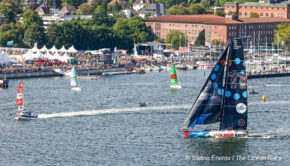How to win the Volvo Ocean Race
Published on August 5th, 2014
When the 2014-15 Volvo Ocean Race starts October 4, the one design Volvo Ocean 65 won’t be the only change to this ocean racing classic. The scoring system will be different too…
“We’ve actually turned the scoring system right around this year,” Race Director Jack Lloyd explains. “Previously, we’ve always used high points scoring. So, if a team finished first out of seven in either an in-port race they’d be awarded seven points, or in an off-shore race, 35 points, as the latter was weighted to be worth five times more than the former.
“This edition, we’ve moved to low points scoring for the first time. It means that the team that finishes first in an off-shore leg, or an in-port race, will be awarded one point. The team that finishes second, two – and third, three points. If you are disqualified, or have to retire, then you earn an extra point.”
“There’s no weighting – the points are the same across the off-shore legs and the in-port races. Now, the objective for all teams is to reach the June finale in Gothenburg with as few points as possible – the lowest wins. It means that, at any time, you can look at how many points a team was awarded for a leg, and instantly know where they finished. But also, from an administration point of view, the move has brought the Volvo Ocean Race into line with the rest of sailing as a sport. It’s much easier to act if two teams tie – the jury use the knowledge that they already have, and they can just refer to the sailing rulebook. We don’t have to write our own.”
And in another change from previous editions, the off-shore legs and the in-port races will be run as two separate series, rather than combining the points as in the past.
“We used to have an overall in-port race winner – so it was already a separate series, if you like. But on closer inspection, that meant that a team could win the in-port series, but there was no trophy for the team who performed the best on only the off-shore legs. In some ways, that meant that we were making more of the in-port races than we were the off-shore legs. Yet, ultimately, we are an off-shore race.”
But isn’t there a risk that the sailors might treat the in-port series as a secondary competition?
Jack shakes his head. “No, they’ll still take it really seriously. Yes, the Volvo Ocean Race will be decided by winning legs – but there’s a possibility that teams could tie on off-shore leg points because of that. What we’ve agreed is that, if that’s the case, then whatever your place in the in-port series will break the tie – meaning that performing well in the in-ports is vital, as it could be the difference between winning and losing.”
And, actually, Jack reckons that, with boats so close that fans can almost touch them, the short, sharp and intense in-port races could be more popular than ever this time around.
“It’s more of a spectacle now. When I took over, the in-ports were about three and a half hours long. This year they will be more like one hour – smaller and closer in-shore. We’re bringing racing right into the beaches.”
The 2014-15 Volvo Ocean Race will take the fleet to 11 cities in 11 countries – Spain, South Africa, United Arab Emirates, China, New Zealand, Brazil, United States, Portugal, France, The Netherlands, and Sweden – and will require the teams to cover 38,739 nautical miles over nearly nine months.
Race website: http://www.volvooceanrace.com/en/home.html
Report by Volvo Ocean Race media. Photo by Ainhoa Sanchez / Volvo Ocean Race.









 We’ll keep your information safe.
We’ll keep your information safe.